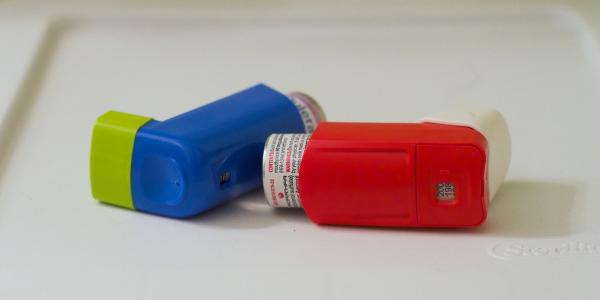Kelly Harris, a doctoral student in education, uses Geographic Information Systems (GIS) to identify ‘hotspots’ of childhood asthma in St. Louis. Higher asthma rates are linked with lower income levels, and Harris wants to understand why. Through data, she seeks to discover solutions to health inequalities in the St. Louis region and beyond.
Transcript:
Claire Navarro (host): Thanks for listening to Hold That Thought. I’m Claire Navarro. Before Kelly Harris began graduate school here at Washington University in St. Louis, she worked for 15 years as a speech pathologist. On paper, the job meant getting to help little kids with language difficulties learn how to speak. But over and over again, she found herself also having to do a different kind of work.
Kelly Harris (guest): So in doing that work I went into a lot of homes and a lot of schools, and I just found that for many families I might end up being a social worker instead of a speech therapist, just because their most pressing needs were not their children's speech at that moment.
CN: The families that Harris met were often dealing with low income levels and high stress levels. In these circumstances, it can be tough to make learning a priority.
KH: Going into homes where I'm trying to get parents to listen to me and to implement these strategies with their kids, and they're worried about having diapers and formula and many other things. Just kind of competing needs, right?
CN: These experiences led Harris to questions - questions about health, about learning, about poverty and inequality, and how all these things overlap.
KH: Really just thinking about, what are prerequisites for learning? Why does being healthy matter? If your primary need is anything from breathing - you know having an asthma exacerbation - to just a toothache, does that impact a child's ability to attend in the classroom, to actively participate, and to really take in information?
CN: In order to look into these kinds of issues, Harris decided to go back to school to pursue a PhD in education. Here at WashU, some of her recent work focuses on one health problem in particular: asthma. There are a few things about asthma that make it important when thinking about the intersection of health and learning.
KH: So it's the number one reason that children miss school. It is a chronic condition. The medications used to treat asthma have a host of side effects that can impact learning.
CN: So, there are lots of ways that asthma can impact a student’s success in school. But asthma doesn’t affect all students at the same rate or in the same way.
KH: Statistics do show that asthma disproportionately impacts poor children and minority children in urban centers.
CN: That’s right. You’d think that something like asthma would be pretty evenly spread out, but in reality, kids who live in urban areas are more likely to have it. This is true across the country. St. Louis, home to Washington University, is no exception.
KH: I've done some studies that have looked at the whole region, so St. Louis City, St. Louis County, St. Charles County. And when you look at the whole region, the entire city is just one big hotspot where asthma rates are really high.
CN: But, as Harris found, just saying “asthma rates are really high in the city,” isn’t really giving the full picture.
KH: So one of the things that I wanted to do was look at the city and figure out, is there variation that we lose when we look at a broader region. And what I found is that there is.
CN: Zoomed out, the city of St. Louis looks like one giant asthma hot spot. But when Harris zoomed in and looked closer, she saw a more complex picture.
KH: So I took all of the zip codes in the city and surrounding zip codes - so any neighboring zip code along the entire boundary of the city - places like Maplewood-Richmond Heights that borders the city, Clayton, and so on. North to south, I took all of those zip codes and said, 'OK, is there any group that has significantly higher rates, that are statistically significant?' And then the same thing for lower rates.
CN: Zip code by zip code, she found that asthma rates do vary across the city. And one part of the city stood out.
KH: In areas in North city, asthma rates are definitely higher.
CN: North city. To understand what’s going on, Harris again turned to maps. This time, instead of mapping something that’s there – like high rates of asthma – she discovered something that’s not there. She found something missing from north St. Louis: doctors.
KH: Geographically, if you look at the City of St. Louis, pediatricians and asthma and allergy immunology physicians that would treat asthma are heavily concentrated in the central corridor and south. So our two major children's hospitals are St. Louis Children's Hospital and Cardinal Glennon, and those are within a couple of miles of each other, central and south. So that leaves the entire north side of the city a good distance away from care. So I mapped actual pediatricians and physicians in the city, and there's less than 10 percent - I want to say less than 5 percent - north. So that's very few physicians to treat a large number of children.
CN: Traveling a longer distance to see a doctor can be a challenge for any family - especially if you don’t have good options for transportation.
KH: If you don't have a car and you're reliant on public transportation to get there, that's a time factor.
CN: A time factor that can easily turn into a stress factor. In some cases taking time off for a child’s doctors visit means not getting paid, or even worse, losing your job. And, unfortunately, a lack of access to healthcare isn’t the only stress that kids with asthma and their families face in north St. Louis.
KH: Those are also areas where public housing is more heavily concentrated, where violent crime rates tend to be higher.
CN: Both of these things are also linked with higher rates of asthma.
KH: One of the things that's associated with asthma is housing conditions, which is a reason that public housing is thought to be associated with asthma as well, in terms of building materials and housing conditions in general. So I looked at the age of housing in the city, and it's all pretty consistently old. Most of the city has a lot of old housing, older than 1950. But there's still a difference in rates.
CN: As we’ve already noted, asthma rates in north St. Louis are higher. On the other hand, in certain parts of South St. Louis, the rates are actually much lower. Those households tend to have higher incomes. More research needs to be done to prove cause and effect for these differences, but Harris has some theories.
KH: So I wonder if maybe higher incomes allow families to better maintain their housing. And so then I looked at city-deemed condemned housing, so houses that the city has said are an unlivable condition. That is very heavily concentrated in areas in North St. Louis City, in the same areas where you find higher asthma.
CN: By tracking and mapping things like asthma rates, housing conditions, doctors and income, Harris is painting a picture of what kids with asthma in these neighborhoods are actually experiencing, and starting to put the puzzle pieces together. We know asthma is linked with poverty – but why exactly is that true?
KH: And so there's a couple of things happening there. Conditions in deteriorating housing are bad for health, and in particular for children who have asthma. That's one. When you think about crime, and well why would crime be associated with asthma, one of the thoughts is that children are kept indoors more - because neighborhoods are thought to be unsafe - and in conditions that may be more poor in quality.
CN: All of these things can cause stress, which in itself is a trigger for asthma symptoms. And the kids themselves aren’t the only ones experiencing stress.
KH: Then household stress. And so one of the things that would be interesting - I haven't done it yet - would be to look at, if the data exist, families who smoke as a response to stress. You know, with children with asthma in the household. Is that geographically interesting at all? Is there a pattern there?
CN: Harris says trying to pin down the causes and effects of asthma in cities like St. Louis is like a chicken and egg scenario. But in this case, it’s much more complicated than a single cause leading to a single effect.
KH: You know, kind of what you find is this more cyclical process - where you have these poor health and education outcomes that feed back into the community and create this intergenerational pattern. Professor Patrick Sharkey suggests that places are inherited and that those patterns exist over generations.
CN: Recognizing these patterns can be frustrating. For Harris, in some ways it’s personal - her son has asthma. It can be hard to think about all the other kids out there who are at risk, who aren’t getting the care they need, or who are missing school and opportunities because of the disease.
KH: When you see - I think as a black woman, and as a mother, when you do this kind of research and you're identifying these patterns that are so heavily rooted in inequality, I think there is always kind of an emotional piece. But I think, you know what's important is moving past that and really looking at the research. But I think it's there for sure.
CN: Part of getting past the frustration comes from looking forward. As we’ve heard, childhood asthma in cities can be connected to many things – housing conditions, healthcare access, stress. Harris believes that solutions to the problem can and should be just as interconnected.
KH: So I think that coordinated policy efforts would be most effective. I think that individual industries like housing health and education have all kind of tried their own things.
CN: Often with limited success. Instead, Harris believes these groups work should work to combine efforts. For example, schools and doctors could join forces to provide healthcare in schools.
KH: School-based health clinics allow children to be in school and still get the services they might need. So hopefully reducing the impact that we see on attendance and thereby improving achievement.
CN: Housing providers could also have a role, she says.
KH: So maybe a housing agency sponsoring some kind of school-based health clinic or health services onsite in low-income housing or public-housing communities. I think those are some options, but just more coordinated policy.
CN: Harris wants her work to provide the kind of data and context needed to make efforts like these successful. By understanding what’s really happening in areas with higher and lower asthma rates, she hopes to help break the cycle wealth and health inequality in cities like St. Louis.
KH: Really providing research that supports policy that can impact that inequality is what I would hope my research can do. That my research is able to say that, 'Yes this is happening, and yes this is a pattern that is based on a history of segregation and inequality. And these are ways that we can address it and fix it.' Not just treat these conditions, but to really get at the roots of the problems.
CN: Many thanks to Kelly Harris for joining Hold That Thought. For many more ideas to explore, please visit us at holdthatthought.wustl.edu and be sure to subscribe.





